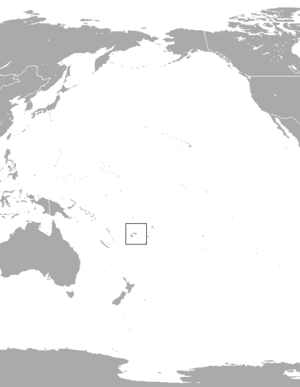Fijian monkey-faced bat facts for kids
Quick facts for kids Fijian monkey-faced bat |
|
|---|---|
 |
|
| A male bat near the top of Mt. Koroturaga in Taveuni, Fiji. This particular bat is the holotype of the species. | |
| Conservation status | |
| Scientific classification | |
| Genus: |
Mirimiri
|
| Species: |
acrodonta
|
 |
|
| Where the Fijian monkey-faced bat lives | |
| Synonyms | |
|
Pteralopex acrodonta |
|
The Fijian monkey-faced bat (Mirimiri acrodonta) is a special type of large bat. It is also known as the Fijian flying fox. This bat lives only on the island of Fiji. Scientists first found it in 1976. They discovered it in an old cloud forest on Des Vœux Peak. This peak is the second highest mountain on Taveuni island. The Fijian monkey-faced bat is the only mammal that is unique to Fiji. This means it is found nowhere else in the world! It used to be in the Pteralopex group of bats. Now, it has its own unique group called Mirimiri.
Contents
What Does the Fijian Bat Look Like?
These bats are quite large. They usually weigh between 222 and 362 grams. That's about as much as a can of soda! Their forearms are about 120 millimeters long. Their fur is thick and a uniform tan color. Sometimes their fur is so thick it hides their ears.
Their wings attach to their bodies closer to their spine.
Where Do These Bats Live?
The Fijian monkey-faced bat is found only on Taveuni island. This is the third-largest island in Fiji. They live only in the mountain forests on the island. These forests are often covered in clouds. It is possible they might also live on Vanua Levu island. However, no one has confirmed this yet. This bat is the only large bat that is unique to Fiji.
What Do We Know About Their Lives?
Scientists do not know much about these bats. They are hard to find and there are very few of them. They seem to hide in clumps of plants that grow on trees. These plants are called epiphytic plants. They live high up in the cloud forest trees.
A pregnant bat was once found in May. Also, female bats that were feeding their babies have been seen in May. Scientists think these bats eat tough plants. They believe this because of the shape of their teeth.
Why Is This Bat in Danger?
Only six of these bats have ever been seen by people. This bat is listed as a critically endangered species. This means it is in extreme danger of disappearing forever. The main reason for this is habitat loss. Their home, the cloud forest, is shrinking.
The population of these bats is very small. Scientists believe there are fewer than 1,000 bats left. The Alliance for Zero Extinction has identified this bat as being in danger of extinction. In 2013, Bat Conservation International put this bat on its list of top 35 species to protect worldwide.
Threats to Their Home
The bat's habitat is being lost and broken up. This is happening because of pollution and farming. Extreme weather events also cause damage. Cities are growing, which also takes away their land.
Climate change is another big problem. It is expected to make cloud forests around the world shrink. This will cause even more habitat loss for the Fijian monkey-faced bat. Even though their forest is a reserve, much of it has been turned into plantations.
Fun Facts About the Fijian Monkey-Faced Bat
- This bat is the only living member of an ancient genus Mirimiri. Its relatives are all extinct.
- The genus name 'Mirimiri' is the Fijian word for "bat."
- It's one of the rarest bats in the world.
- They don't hunt insects. They are frugivores, meaning their diet consists mainly of fruits.
- Unlike many bats, they do not have tails.
- Most bats have dark brown or black eyes, but the Fijian monkey-faced bat has beautiful, vibrant orange eyes, which is extremely unusual.
- It appears to be mostly solitary or live in very small groups, unlike the massive colonies formed by many other fruit bat species.


